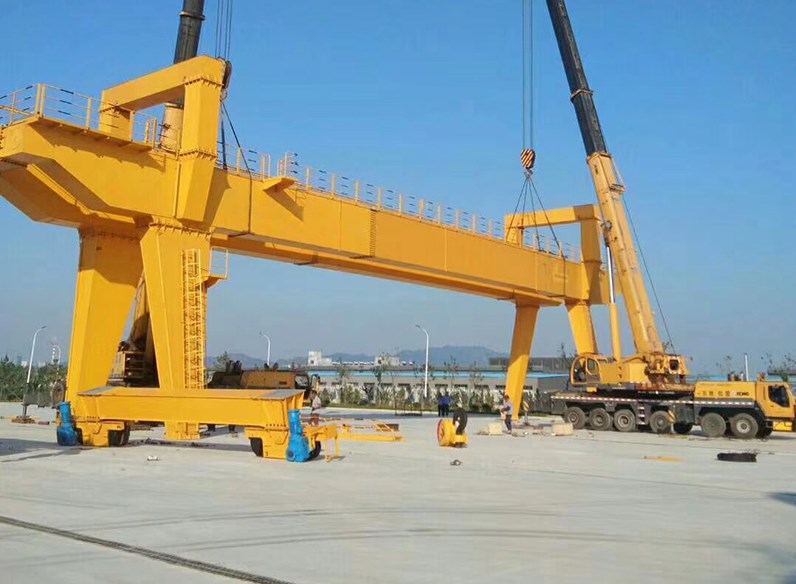Navigating the Installation of a 50-Ton Gantry Crane
In the realm of heavy lifting solutions, the 50-ton gantry crane stands as a robust and versatile workhorse, capable of maneuvering within confined spaces while effortlessly hoisting hefty loads. The installation of such a formidable piece of machinery is a critical process that demands precision, expertise, and adherence to safety protocols. In this article, we delve into the intricacies of the installation process for a 50-ton gantry crane, exploring the key steps involved in bringing this mechanical giant to life.
Site Preparation:
Before the first bolt is tightened or the crane components are unpacked, meticulous site preparation is essential. The ground where the gantry crane will operate must be level and capable of supporting the crane's substantial weight and the loads it will carry. Engineers typically conduct soil tests to ensure stability and determine the necessary foundation requirements.
Once the foundation is established, attention turns to ensuring that the installation site is free from obstructions. Adequate clearance and proximity to the intended work area are critical considerations. This initial phase sets the stage for a seamless installation process.
Structural Assembly:
The heart of any gantry crane lies in its structural integrity. The assembly of the gantry frame, legs, and end carriages is a meticulous process that requires precision and expertise. The components, often delivered in modular sections, must be carefully aligned and securely connected to form the crane's skeletal structure.
Each leg is positioned according to the specified span and width, and the end carriages are mounted on the legs. These carriages house the wheels that facilitate the horizontal movement of the crane along the tracks or ground. Bolting and welding are performed with meticulous attention to detail to ensure the structural stability required for the crane's lifting capacity.
Hoisting Mechanism Installation:
The hoisting mechanism is the powerhouse of the gantry crane, responsible for lifting and lowering heavy loads with precision. The installation of the hoist involves mounting it onto the trolley, which moves along the bridge girder of the gantry crane.
During this phase, the crane's electrical components, including the motor and control systems, are integrated. Safety features such as limit switches, emergency stop buttons, and overload protection devices are meticulously connected to ensure seamless functionality and compliance with safety standards.
Trolley and Bridge Assembly:
With the hoisting mechanism in place, attention turns to the assembly of the trolley and bridge. The trolley, housing the hoist and hook, moves horizontally along the bridge girder, providing lateral movement for load positioning. The bridge, supported by the end carriages, spans the width of the gantry crane.
The bridge assembly involves securing the bridge girder to the end carriages, ensuring proper alignment and balance. The trolley is then installed on the bridge, with precision rail systems allowing smooth movement along the entire span.
Electrical System Integration:
The electrical system is the nerve center of a gantry crane, orchestrating its various movements and ensuring the safety of both operators and loads. During installation, meticulous attention is given to wiring and connecting the electrical components. Control panels, often featuring advanced interfaces for ease of operation, are integrated into the crane's design.
Modern gantry cranes may also incorporate smart technologies, such as remote control systems and computerized monitoring, enhancing efficiency and safety. Rigorous testing of the electrical system is conducted to identify and rectify any issues before the crane becomes operational.
Safety Checks and Testing:
Safety is paramount in the installation process of a 50-ton gantry crane. Rigorous safety checks are conducted to verify the functionality of emergency stop systems, limit switches, and overload protection mechanisms. Load testing is a critical step, ensuring that the crane performs within specified parameters and can safely handle its rated capacity.
During this phase, engineers meticulously evaluate the crane's response to various operational scenarios, including load pickups, movements along the span, and precise placements. Any anomalies or deviations from safety standards are addressed promptly to guarantee the crane's reliability.
Operator Training:
With the gantry crane successfully installed and safety checks completed, operator training becomes a pivotal step. Operators must be proficient in the operation of the crane, including understanding control interfaces, emergency procedures, and load-handling techniques.
Training programs often include both theoretical and practical components, allowing operators to familiarize themselves with the nuances of the specific gantry crane model. Emphasis is placed on safety protocols, efficient load handling, and the optimal use of the crane's features.
Commissioning and Handover:
The culmination of the installation process is the commissioning of the 50-ton gantry crane. This involves a comprehensive review of all systems, ensuring that the crane operates seamlessly and in accordance with design specifications. The handover to the client or end-user follows a successful commissioning, marking the crane's readiness for operational use.
Conclusion:
The installation of a 50-ton gantry crane is a complex and highly orchestrated process that demands a fusion of engineering expertise, precision, and strict adherence to safety standards. From site preparation to the commissioning phase, each step plays a pivotal role in bringing this mechanical marvel to life. As industries continue to rely on heavy lifting solutions for their operational needs, the installation of these powerful machines underscores the commitment to efficiency, safety, and the seamless orchestration of industrial processes.



Comments
Post a Comment